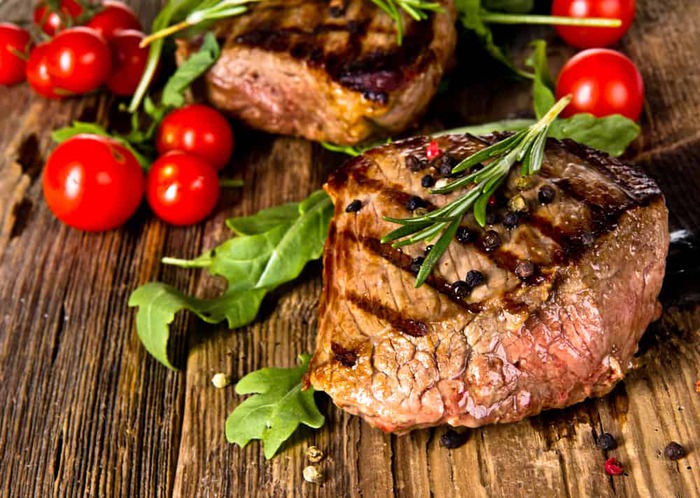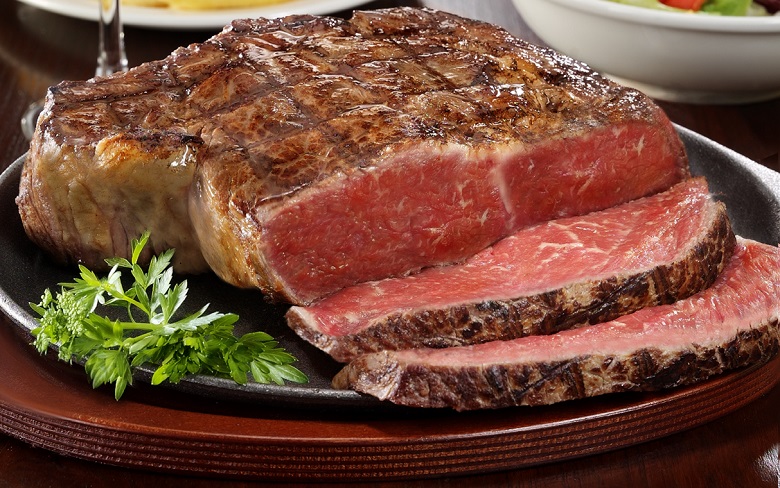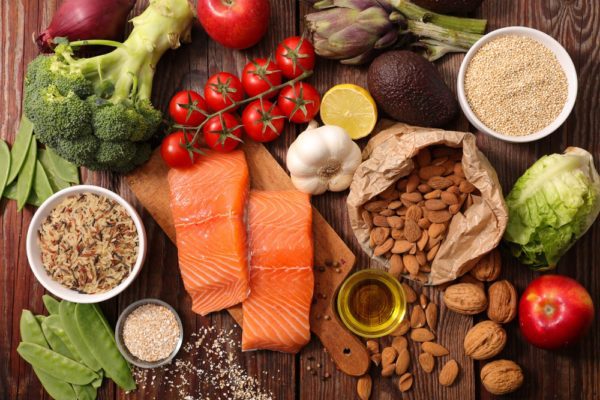Heme in red meat, good or bad?

Multiple studies show that there is in fact a link between red meat consumption and heart disease. This link has been heavily supported by a finding that makes a strong association between heme iron, found only in meat, and potentially deadly coronary heart disease. The incidence of coronary heart disease increased 57 percent when heme iron was consumed (1). In addition, there was no link between non-heme iron, the type of iron that is found in plant sources and other non-meat sources (1). The red meat that we consume contains both types of iron. Heme iron makes up about 40-45 percent and the rest is non-heme iron. When talking about heme iron, red meat is the best source. When we ingest red meat, we consume the blood proteins, the hemoglobin and myoglobin contained in the flesh of the animal (2). Heme iron is very easily absorbed and is a great source of iron to individuals that are iron deficient. Even though about 20 to 25 percent of heme iron is absorbed, heme however, may be dangerous, especially when it is free in biologic systems. Vercellotti et al. 1994 have shown that heme catalyzes the oxidation of low density lipoproteins (LDL), bad cholesterol, which can damage vascular endothelial cells. Due to heme being highly hydrophobic, it readily intercalates into endothelial membranes and potentiates oxidant-mediated damage (3).
The fate of heme within the intestinal lining cell is degradation and this is mediated by heme oxygenase. Majority of studies have concluded that heme oxygenase is the main enzyme in processing the newly absorbed heme (4), but has not been proven definitely. Heme oxygenase is a rate limiting enzyme in the catabolism or breaking down of heme. It is normally expressed at low levels in most tissues, but it is highly inducible by a variety of stimuli. In fact the isoform heme oxygenase-1 may be among the most critical mechanisms that are activated during times of cellular stress such as inflammation, ischemia, hypoxia, hyperoxia, hyperthermia, and radiation. It may also play a key role in preventing vascular injury (5). This same study has shown that heme oxygenase-1 is an antiatherogenic gene in animal models and that the lack of heme oxygenase-1 has been reported to promote atherosclerosis in mice. Similarly, the gene has a similar effect with pharmacological manipulation.

The Harvard School of Public Health conducted research linking red meat and mortality. The study found that a serving on any type of unprocessed red meat increased the risk of dying earlier in life by 13 percent. In addition, the risk was upped by 20 percent when processed red meat was consumed (6). The study lasted for an average of 24 years following more than 120,000 men and women. The participants submitted information about their diets every four years. Over the course of the 24 years roughly 24,000 participants died. It is important to note that the death rates were highest among the participants that ate the most red meat compared to those who ate the least. This was one of the longest studies completed on the subject of red meat and survival. On the other hand, a Japanese study was done that followed men and women for 16 years. This study showed no link between moderate meat consumption and premature death (6). The moderate quantity of meat was up to three ounces of red meat a day. A different group at The Harvard School of Public Health found that there was no connection at all between eating unprocessed red meat and the development of diabetes and heart disease, while there was a strong connection with eating processed red meat. It is suggested that the increased risk from red meat may come from the saturated fat, cholesterol, and iron it delivers (6). Also compounds that are known cancer causing agents when red meat is cooked at high temperatures. In processed foods it is possible that the sodium plays a larger role. Then again it is possible that meat eaters may have other risk factors for serious diseases.
The incidence of cardio vascular disease events between 2000 and 2007 was 8.5 cases out of 1000 persons. De Oliveira Otto et al., 2012 reported a significant positive trend across dietary intakes of heme iron and risk of cardio vascular disease. The study further investigated the positive association with heme iron. The study compared different sources of heme iron and found that the heme iron from red meat was associated with cardio vascular disease while heme iron from poultry and fish did not associate with cardio vascular disease. Due to no effect from heme iron in non-red meat sources the findings suggest that the associations observed might reflect other constituents of red meat or that these components might interact with heme iron thus altering their bioavailability and producing the observed associations with incident disease (7). With all data combined, the study suggests that other elements present in red meat may influence risk of cardio vascular disease.

The American Diabetes Association wanted to find out if a diabetes related abnormality would exacerbate the adverse effects of heme iron overload on cardio vascular health. Women who reported a diagnosis of type II diabetes were assessed on the associations of long-term intakes of dietary iron and red meat with coronary heart disease risk. This 20-yearlong study singled out 550 cases of coronary heart disease: 259 were nonfatal myocardial infarctions, 153 coronary heart disease deaths, and 138 bypass operations or angioplasties (8). In addition, women in the highest quintile of heme iron intake were more likely to have hypertension than women in the lowest quintile (8). The women in the study showed having a 50 percent increased risk of total coronary heart disease when compared to women with the lowest intake. Independent of age and BMI there was a significant increased risk of fatal and total coronary heart disease. The study concluded that women diagnosed with type II diabetes were at a high risk of coronary heart disease when dietary heme iron was consumed from red meat. The associations between heme iron intake and increased cardiovascular events were also observed in other studies.
Only recently has the field started to recognize the negative effects of heme on the cardio vascular system. Additional studies are necessary to further investigate how excess heme from red meat affects cardiovascular health. We know that heme is critical for the function of a wide variety of proteins and that free heme accumulation causes cellular damage. These studies show a trend of negative effect, but they fail to provide a clear reasoning as to why.
References
- Indiana University. "Iron consumption can increase risk for heart disease, study shows." ScienceDaily. ScienceDaily, 23 April 2014. <www.sciencedaily.com/releases/2014/04/140423170903.htm>.
- Iron Disorders Institute. (2019). Iron We Consume. [online] Available at: https://www.irondisorders.org/iron-we-consume.
- Vercellotti, G., Balla, G., Balla, J., Nath, K., Eaton, J. and Jacob, H. (1994). Heme and the Vasculature: an Oxidative Hazard that Induces Antioxidant Defenses in the Endothelium. Artificial Cells, Blood Substitutes, and Biotechnology, 22(2), pp.207-213.
- Sciencedirect.com. (2019). Heme - an overview | ScienceDirect Topics. [online] Available at: https://www.sciencedirect.com/topics/immunology-and-microbiology/heme.
- Araujo, J., Zhang, M. and Yin, F. (2012). Heme Oxygenase-1, Oxidation, Inflammation, and Atherosclerosis. Frontiers in Pharmacology, 3.
- Publishing, H. (2019). What's the beef with red meat? - Harvard Health. [online] Harvard Health. Available at: https://www.health.harvard.edu/healthbeat/whats-the-beef-with-red-meat.
- de Oliveira Otto, M., Alonso, A., Lee, D., Delclos, G., Bertoni, A., Jiang, R., Lima, J., Symanski, E., Jacobs, D. and Nettleton, J. (2012). Dietary Intakes of Zinc and Heme Iron from Red Meat, but Not from Other Sources, Are Associated with Greater Risk of Metabolic Syndrome and Cardiovascular Disease. The Journal of Nutrition, 142(3), pp.526-533.
- Qi, L., van Dam, R., Rexrode, K. and Hu, F. (2006). Heme Iron From Diet as a Risk Factor for Coronary Heart Disease in Women With Type 2 Diabetes. Diabetes Care, 30(1), pp.101-106.
Majid Hodzic
